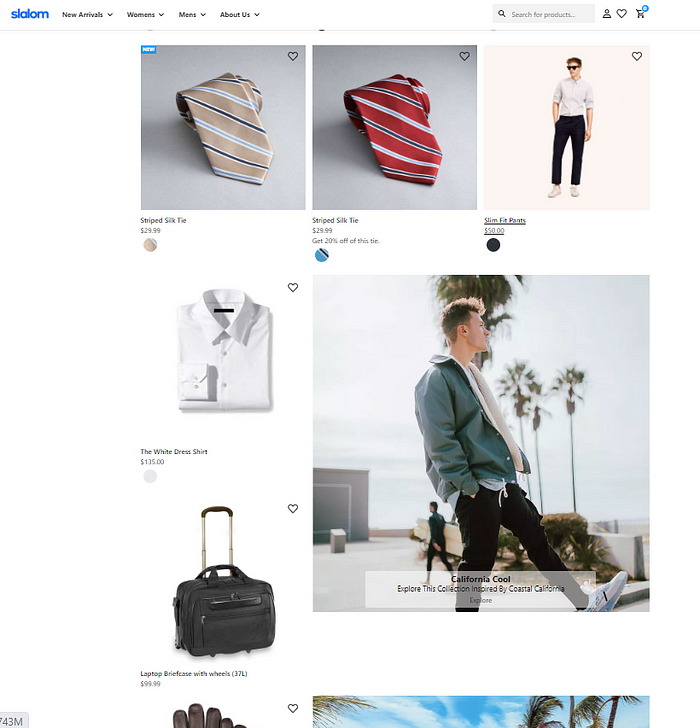

The Headless Journey with Slalom's Composable Accelerator | Slalom Technology
source link: https://medium.com/slalom-technology/starting-the-headless-journey-with-slaloms-composable-accelerator-d2973b105114
Go to the source link to view the article. You can view the picture content, updated content and better typesetting reading experience. If the link is broken, please click the button below to view the snapshot at that time.
Starting the Headless Journey with Slalom’s Composable Accelerator
Modernizing your ecommerce site doesn’t have to be so hard.

Photo by Gustavo Fring from Pexels
By Rob Pontious and Lena Lykhodii
The last few years have been explosive in growth and activity for commerce, especially ecommerce — due in part to the COVID-19 pandemic. Companies that were online but couldn’t support digital redemption of in-store vouchers, or weren’t ready with curbside (or centralized in-store) pick-up services, were the first to charge down the path. Consumers demanded richer, faster web (and other digital) experiences that also served channels like apps or kiosks. Slalom met with many leadership teams and heard from enterprise architects: “We need to go headless.”
Introduction to headless architecture
A “headless” solution leverages a specialized architectural design that separates the front and back ends of a site. For many years, most companies have had a “headed,” or traditional, design — pushing out code with strong dependencies between the front and back end.
Why go headless?
Headless solutions are more flexible from the perspective of “Do what you want on the front end. Let the back end do what it needs to do, to make the site work.” Marketing and merchandisers like this approach for the faster pace of front-end customization it allows. IT managers like it because they are able to protect the functionality of the site.
In addition, headless solutions are faster, especially with newer technologies on the front end. Every one-second increase in performance translates to a roughly 17% increase in conversion. Customers like fast sites — quick shopping and a simple click to check out. That makes sense, right?
Challenges to going headless
So, why didn’t everyone go headless during the ecommerce boom over the past few years?
One reason is that it can be a long and costly project. You need teams that can support all the different tasks from expanded merchandising to content management. You need front-end teams that build and support custom experiences and back-end developers to integrate the web services and APIs that make a successful customer interaction possible (loyalty, payment, tax, fraud, and more).
Let’s look at one of these areas more closely to better understand the complexities that can be involved:
Content can really be the key to success. Brands want dynamic, reusable content that drives a clear message for customers, tailored specifically to them. You want that experience to be the same for an individual customer, across all channels. This is connected commerce. This is the personalized experience consumers are demanding. And it’s a lot of work. If you don’t plan your design and roadmap right, a composable modernization project can quickly get away from you.
Slalom wants to help you on that journey.
Accelerate your headless journey with composable commerce
Getting started doesn’t have to mean rebuilding everything, especially if you’re already on Salesforce B2C Commerce. Are you still on SiteGenesis? Or, maybe you’ve moved ahead to Storefront Reference Architecture (SFRA)? You may be thinking, how can I go headless without rebuilding everything to give my customers a faster, fresh commerce experience?
We hear your customers. We hear you. You need a hybrid approach. For example, keeping checkout as is, or maybe you still need the business manager’s preferences or content system. The Slalom Composable Accelerator does just that!
Following Salesforce’s release of their composable storefront, Slalom developed its own reference application to help clients start their headless journey. Slalom’s Composable Accelerator enables a robust digital storefront with seamless, best-in-class content management. While your marketing team moves content to the CMS, new front-end experiences are made for portions of the site. We’re constantly adding important new features like badging, product zoom, tile swatches and alternate images, store locator functionality, and more.
Brands that already have a digital storefront on Salesforce B2C Commerce can leverage the Slalom Composable Accelerator for both hybrid and full implementations. The accelerator is perfect for new projects and existing customers that want to move to headless quickly, keeping checkout and enabling shoppers to seamlessly navigate between pages. It uses a technique called session bridging powered by Salesforce’s SLAS plug-in.
The Slalom Composable Accelerator also offers the ability to leverage Salesforce Commerce site preferences to easily configure and manage features and functionality. Need to use your existing content library? No problem! You can repurpose existing content slots and assets as well as leverage Page Designer. Once the styling is updated to match your new storefront, you can utilize content that was previously created for SFRA or SiteGenesis.
And that isn’t all. We’re moving toward the future together and need to consider content that can reach all the channels customers interact with. That’s why the Slalom Composable Accelerator is integrated with Amplience content management system (CMS).

A sneak peek at Slalom’s Composable Accelerator.
The Amplience Salesforce Composable Commerce (ASCC) app is a storefront technology for composable commerce using Amplience and Salesforce APIs. Developers will be thrilled to leverage React as this technology provides them with a more flexible and agile approach to building and maintaining modern ecommerce experiences. Amplience allows you to manage site content, assets, and experiences with a few easy clicks. It supports all site content, including product listing page (PLP) in-grid content for the marketing tiles that merchandising teams love, dynamic site navigation, product page, and footer content. Shoppable content components are also available with rich media like images and video. Additionally, Amplience allows for real-time visualization of all content and personalization based on a user’s groups.
Conclusion
Implementing an effective headless ecommerce solution will improve storefront performance, drive customer engagement, and increase conversion. Slalom’s Composable Accelerator with Amplience content management is a great first stop on that journey. Based on your unique business requirements, Slalom will help you launch a new composable storefront on the Salesforce Commerce platform, accelerate time to value, reduce total cost of ownership, and empower your brand to evolve at the speed of customer expectations. Let the journey begin!
Recommend
About Joyk
Aggregate valuable and interesting links.
Joyk means Joy of geeK